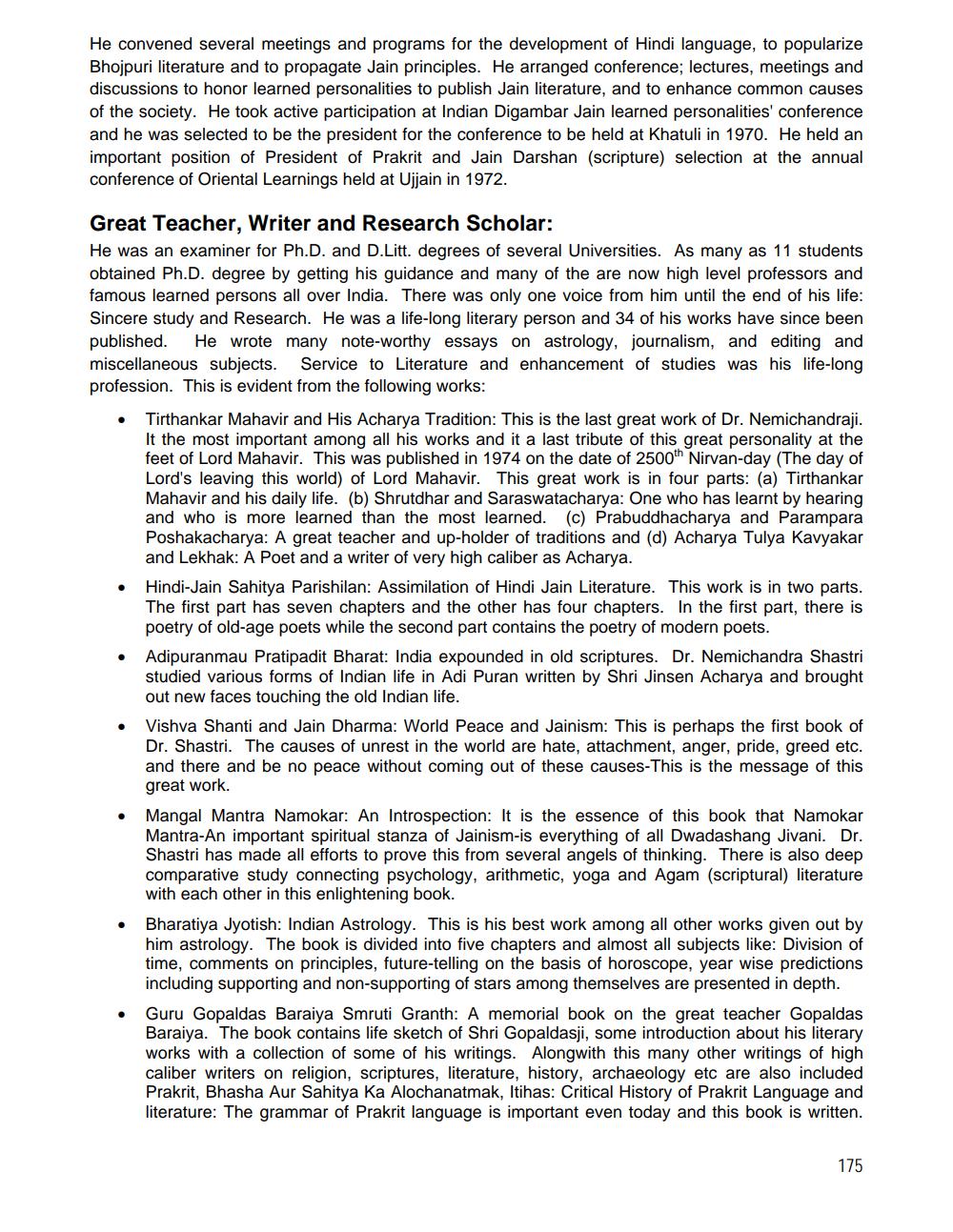________________
He convened several meetings and programs for the development of Hindi language, to popularize Bhojpuri literature and to propagate Jain principles. He arranged conference; lectures, meetings and discussions to honor learned personalities to publish Jain literature, and to enhance common causes of the society. He took active participation at Indian Digambar Jain learned personalities' conference and he was selected to be the president for the conference to be held at Khatuli in 1970. He held an important position of President of Prakrit and Jain Darshan (scripture) selection at the annual conference of Oriental Learnings held at Ujjain in 1972.
Great Teacher, Writer and Research Scholar: He was an examiner for Ph.D. and D.Litt. degrees of several Universities. As many as 11 students obtained Ph.D. degree by getting his guidance and many of the are now high level professors and famous learned persons all over India. There was only one voice from him until the end of his life: Sincere study and Research. He was a life-long literary person and 34 of his works have since been published. He wrote many note-worthy essays on astrology, journalism, and editing and miscellaneous subjects. Service to Literature and enhancement of studies was his life-long profession. This is evident from the following works:
•
Tirthankar Mahavir and His Acharya Tradition: This is the last great work of Dr. Nemichandraji. It the most important among all his works and it a last tribute of this great personality at the feet of Lord Mahavir. This was published in 1974 on the date of 2500" Nirvan-day (The day of Lord's leaving this world) of Lord Mahavir. This great work is in four parts: (a) Tirthankar Mahavir and his daily life. (b) Shrutdhar and Saraswatacharya: One who has learnt by hearing and who is more learned than the most learned. (c) Prabuddhacharya and Parampara Poshakacharya: A great teacher and up-holder of traditions and (d) Acharya Tulya Kavyakar and Lekhak: A Poet and a writer of very high caliber as Acharya. Hindi-Jain Sahitya Parishilan: Assimilation of Hindi Jain Literature. This work is in two parts. The first part has seven chapters and the other has four chapters. In the first part, there is poetry of old-age poets while the second part contains the poetry of modern poets. Adipuranmau Pratipadit Bharat: India expounded in old scriptures. Dr. Nemichandra Shastri studied various forms of Indian life in Adi Puran written by Shri Jinsen Acharya and brought out new faces touching the old Indian life. Vishva Shanti and Jain Dharma: World Peace and Jainism: This is perhaps the first book of Dr. Shastri. The causes of unrest in the world are hate, attachment, anger, pride, greed etc. and there and be no peace without coming out of these causes-This is the message of this great work. Mangal Mantra Namokar: An Introspection: It is the essence of this book that Namokar Mantra-An important spiritual stanza of Jainism-is everything of all Dwadashang Jivani. Dr. Shastri has made all efforts to prove this from several angels of thinking. There is also deep comparative study connecting psychology, arithmetic, yoga and Agam (scriptural) literature with each other in this enlightening book. Bharatiya Jyotish: Indian Astrology. This is his best work among all other works given out by him astrology. The book is divided into five chapters and almost all subjects like: Division of time, comments on principles, future-telling on the basis of horoscope, year wise predictions including supporting and non-supporting of stars among themselves are presented in depth. Guru Gopaldas Baraiya Smruti Granth: A memorial book on the great teacher Gopaldas Baraiya. The book contains life sketch of Shri Gopaldasji, some introduction about his literary works with a collection of some of his writings. Alongwith this many other writings of high caliber writers on religion, scriptures, literature, history, archaeology etc are also included Prakrit, Bhasha Aur Sahitya Ka Alochanatmak, Itihas: Critical History of Prakrit Language and literature: The grammar of Prakrit language is important even today and this book is written.
175




